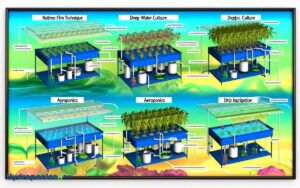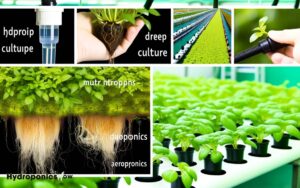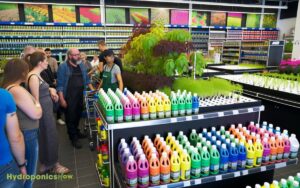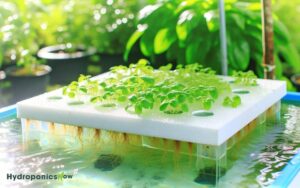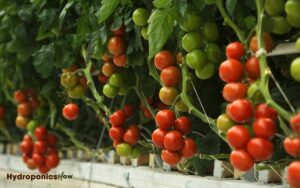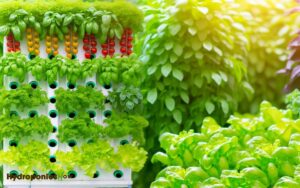Types of Vertical Hydroponics Systems: Optimal Choices!
Vertical hydroponics systems encompass several advanced techniques suited for efficient plant cultivation.
- Tower Gardens maximize space with stacked layers, enhancing nutrient delivery.
- Aeroponic Systems suspend roots in the air, misting them with nutrients for accelerated growth.
- Nutrient Film Technique (NFT) uses a shallow nutrient stream for ideal nutrient uptake.
- Vertical Wick Systems rely on capillary action for energy-efficient nutrient delivery.
- Drip Hydroponic Systems offer precise control over nutrient distribution through emitters.
Specialized systems include Dutch Buckets for larger plants, Vertical Aquaponics integrating fish waste for nutrients, Rotating Vertical Gardens for even light distribution, and A-Frame Hydroponics for compact spaces.
Explore further to understand their distinct benefits and applications.
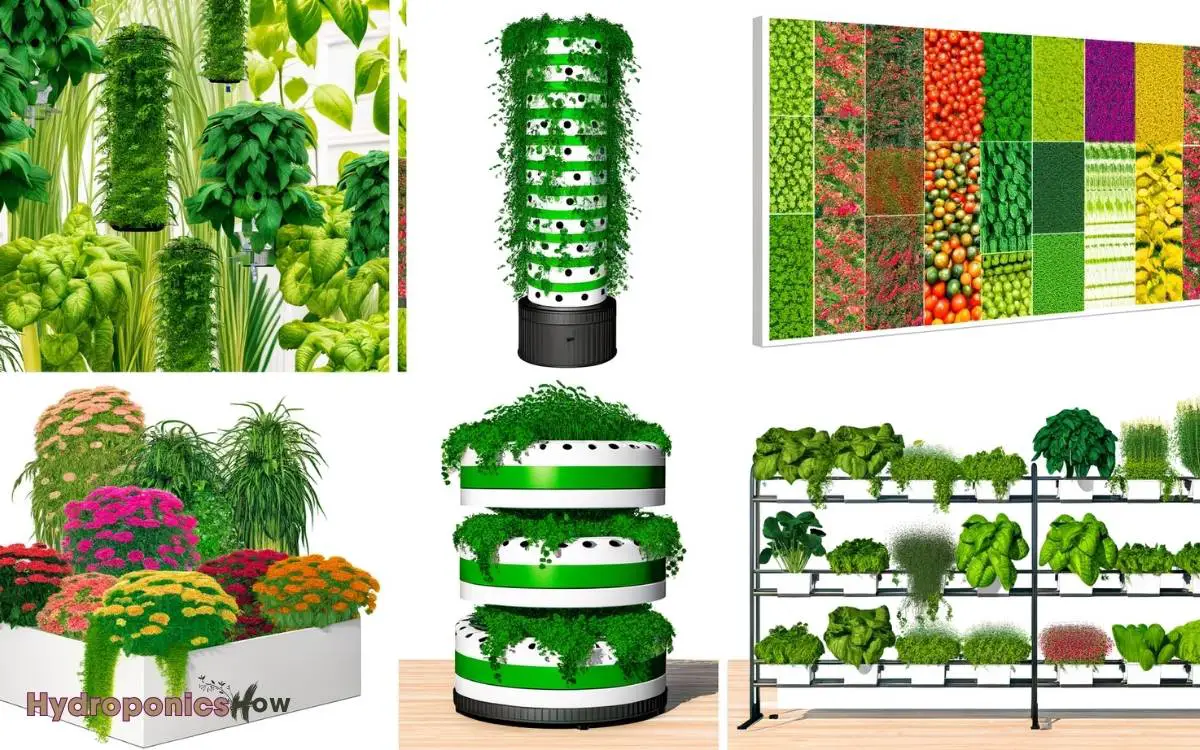
Key Takeaways
Tower Gardens
Tower gardens, a type of vertical hydroponics system, utilize stacked layers to maximize space efficiency and optimize nutrient delivery for plant growth.
These systems are characterized by their vertical configuration, which allows multiple plants to be grown in a minimal footprint, making them ideal for urban environments and small spaces.
Each layer in the tower supports individual plants, with a centrally located nutrient reservoir that is continuously cycled through the system. This guarantees that all plants receive a consistent supply of water and nutrients.
The design of tower gardens also promotes effective air circulation and light exposure, which are critical for healthy plant development.
As a result, tower gardens can achieve higher yields compared to traditional horizontal hydroponics systems.
Aeroponic Systems
While tower gardens exemplify a vertical approach to hydroponics, aeroponic systems represent an advanced technique where plant roots are suspended in air and misted with nutrient-rich solutions, optimizing oxygen availability and nutrient absorption.
This method enhances root health, accelerates growth, and maximizes yield.
| Key Feature | Description |
|---|---|
| Root Suspension | Roots are suspended in air, not submerged in water or soil. |
| Nutrient Delivery | Nutrients are delivered via a fine mist, ensuring even distribution. |
| Maintenance | Requires precise control systems to maintain misting intervals and nutrient composition. |
The system’s efficiency in water and nutrient usage makes it a sustainable choice for modern agriculture. However, it demands meticulous management and monitoring to prevent root desiccation and maintain consistent nutrient supply.
Nutrient Film Technique (NFT)
Nutrient Film Technique (NFT) is a hydroponic system wherein a shallow stream of nutrient-rich solution continuously flows over the roots of plants, guaranteeing efficient nutrient uptake and oxygenation.
In this system, plants are placed in channels with a slight tilt, allowing gravity to facilitate the flow of the nutrient solution. The roots are exposed to air, promoting superior oxygenation and preventing waterlogging.
NFT systems are highly efficient, using minimal water and nutrients, making them ideal for leafy greens and herbs. However, they require precise control of flow rates and nutrient concentration to avoid root drying or nutrient deficiencies.
The system’s simplicity allows for easy scalability and maintenance, yet it demands careful monitoring to ensure optimal plant health.
Vertical Wick Systems
Vertical Wick Systems in hydroponics offer a unique approach to nutrient delivery by utilizing capillary action through various wick materials, such as cotton or nylon.
The efficiency of nutrient uptake in these systems hinges on the choice of wick material and its interaction with the nutrient solution.
Additionally, the suitability of plants for vertical wick systems depends on their root structure and nutrient requirements, making this a crucial consideration for ideal growth.
Wick Material Choices
Selecting the appropriate wick material is essential for optimizing nutrient delivery and ensuring the efficiency of vertical hydroponic systems.
The wick material must exhibit high capillary action, durability, and compatibility with nutrient solutions. Several commonly used materials include cotton, nylon, and felt.
| Material | Capillary Action | Durability |
|---|---|---|
| Cotton | High | Moderate |
| Nylon | Medium | High |
| Felt | High | High |
Cotton wicks, known for their excellent capillary action, are biodegradable but may degrade quickly. Nylon wicks offer durability and moderate capillary properties but lack biodegradability.
Felt wicks strike a balance with high capillary action and durability, making them ideal for long-term use. Choosing the right material can greatly impact system performance and plant health.
Nutrient Delivery Methods
Understanding the various nutrient delivery methods in vertical wick systems is paramount for maximizing plant growth and ensuring the efficient use of resources.
Vertical wick systems rely on capillary action, where nutrients are drawn upward from a reservoir through wicks to the plant roots. This method is passive, requiring no pumps or complex machinery, making it energy-efficient.
Key considerations include:
- Wicking material: Selection of materials like cotton, nylon, or felt affects nutrient absorption rates.
- Reservoir placement: Ideal positioning ensures consistent nutrient flow.
- Nutrient solution concentration: Balancing nutrient levels is essential to prevent deficiencies or toxicities.
- System maintenance: Regular monitoring prevents clogging and ensures the wicks remain effective.
These factors collectively influence the effectiveness of nutrient delivery in vertical wick systems.
Plant Suitability Factors
The plant suitability factors for vertical wick systems hinge critically on species-specific root structure compatibility, light requirements, and growth habits.
Plants with shallow root systems are best suited due to the limited substrate depth. Light requirements must align with the vertical system’s configuration to guarantee even distribution.
Growth habits, such as compactness and vertical growth tendencies, influence plant health and yield.
| Factor | Ideal Characteristics | Examples |
|---|---|---|
| Root Structure | Shallow, fibrous | Lettuce, Spinach |
| Light Requirements | Moderate to high, uniform | Basil, Mint |
| Growth Habits | Compact, vertical growth | Strawberries, Kale |
Analyzing these factors is crucial for optimizing plant selection in vertical wick systems, maximizing efficiency, and ensuring sustainable and productive growth.
Drip Hydroponic Systems
Drip hydroponic systems, frequently utilized in vertical farming, employ a network of tubes and emitters to deliver nutrient-rich water directly to the plant roots, ensuring efficient nutrient uptake and water usage.
This method offers precise control over the nutrient solution, reducing waste and optimizing growth conditions. The system can be tailored to various plant types by adjusting the flow rate and nutrient concentration.
Key advantages include:
- Water Efficiency: Minimizes water usage by delivering it directly to the root zone.
- Scalability: Easily adaptable for both small-scale and large-scale operations.
- Nutrient Control: Precise nutrient delivery enhances plant health and yield.
- Versatility: Suitable for a wide range of plants and adaptable to different growing environments.
This system is ideal for maximizing productivity in vertical farming setups.
Ebb and Flow Systems
Ebb and Flow systems, also known as flood and drain systems, operate through a periodic flooding of the grow tray with nutrient solution, followed by a complete drainage back into a reservoir.
Key components include a submersible pump, a timer, and a grow tray, all working in unison to control the nutrient delivery cycles.
This method offers advantages such as efficient nutrient uptake and oxygenation of roots, but it also has limitations including potential clogging and the need for precise timing to prevent plant stress.
Working Mechanism Explained
In an Ebb and Flow system, nutrient-rich water periodically floods the grow bed and subsequently drains, creating a favorable environment for plant roots by alternating between wet and dry cycles.
This dynamic mechanism promotes efficient nutrient uptake and improved oxygenation. The cycle is controlled by a timer that activates a pump, filling the grow bed with water. Once the timer switches off, gravity allows the water to drain back into the reservoir.
This method provides several benefits:
- Enhanced Root Oxygenation: Intermittent exposure to air prevents root rot and promotes healthy growth.
- Efficient Nutrient Use: Periodic flooding ensures even distribution of nutrients.
- Reduced Water Waste: Recirculating water minimizes wastage.
- Scalability: Suitable for both small and large-scale operations.
This detailed mechanism underscores the system’s effectiveness in fostering ideal plant growth.
Key Components Overview
A thorough understanding of the key components in Ebb and Flow systems is essential for optimizing their functionality and efficiency.
Central to these systems are the grow trays, which house the plants and their root systems. These trays are periodically flooded with nutrient-rich water from a reservoir via a submersible pump.
The pump is controlled by a timer, guaranteeing precise cycles of flooding and draining. Drainage is facilitated through overflow fittings, maintaining appropriate water levels and preventing oversaturation.
The reservoir, containing the nutrient solution, requires regular monitoring for pH and nutrient concentration.
Additionally, aeration devices within the reservoir ensure adequate oxygenation, vital for root health. Understanding these components is paramount for achieving robust plant growth and maximizing system efficacy.
Advantages and Limitations
While grasping the key components provides a solid foundation, it is equally important to contemplate the advantages and limitations inherent in Ebb and Flow systems to fully appreciate their practical applications in hydroponic farming.
This system offers several advantages, including effective oxygenation and nutrient distribution, making it suitable for a variety of crops. However, the system is not without its limitations.
For a balanced perspective, consider the following:
Advantages:
- Efficient nutrient use and recycling.
- Enhanced oxygenation of root zones.
Limitations:
- Requires reliable power supply to avoid pump failure.
- Potential for root diseases due to stagnant water.
Understanding these factors aids in making informed decisions about implementing Ebb and Flow systems in vertical hydroponics.
Dutch Bucket Systems
Dutch bucket systems, a popular choice for hydroponic growers, utilize individual containers connected to a central reservoir, allowing for efficient nutrient delivery and water management.
Each bucket typically contains a growing medium such as perlite or coconut coir, providing robust root support.
The system operates via a drip irrigation method, where nutrient-rich water is delivered to each bucket through a network of tubing. Excess water drains into a return line, ensuring ideal hydration and preventing waterlogging.
This closed-loop system minimizes water waste and allows precise control over nutrient concentrations.
Dutch bucket systems are particularly advantageous for growing larger, fruiting plants like tomatoes and peppers, offering scalability and adaptability to various growing environments.
Vertical Aquaponics
Integrating fish and plant cultivation, vertical aquaponics leverages the symbiotic relationship between aquaculture and hydroponics to create an efficient, sustainable farming system.
This approach capitalizes on nutrient recycling, where waste produced by fish provides essential nutrients for plant growth while plants help to filter and purify the water for the fish.
Key benefits include:
- Resource Efficiency: Minimizes water usage by recycling it within the system.
- Nutrient-Rich Environment: Utilizes fish waste to create a natural, nutrient-dense medium for plants.
- Space Optimization: Vertical stacking allows for high-density planting in limited spaces.
- Sustainability: Reduces reliance on chemical fertilizers and pesticides.
This innovative method enhances productivity and environmental stewardship, making it ideal for urban and rural applications alike.
Rotating Vertical Gardens
Building on the principles of efficient space utilization and maximizing plant exposure to light, rotating vertical gardens introduce a dynamic mechanism that continuously moves plants to guarantee uniform light distribution and ideal growth conditions.
These systems typically employ a motorized framework that rotates plant columns or panels, ensuring each plant receives consistent exposure to the light source. This movement mitigates shadows and prevents phototropism, where plants grow unevenly towards the light.
Additionally, the rotation aids in air circulation, reducing the risk of fungal diseases and promoting robust plant health.
The integration of automation in these systems enhances precision in nutrient delivery and irrigation, making them highly efficient for urban agriculture and commercial applications where space and resource optimization are paramount.
A-Frame Hydroponics
A-Frame hydroponics systems, characterized by their triangular structure, optimize vertical space and facilitate efficient nutrient and water delivery to a high density of plants. This design is particularly advantageous for urban farming and small spaces, allowing growers to cultivate a variety of crops with minimal land use. Among the best hydroponic system options, A-Frame setups stand out for their ability to maximize light exposure and airflow, promoting healthier plant growth. Additionally, they support sustainable farming by reducing water waste and improving overall resource efficiency.
These systems are particularly adept at maximizing limited space, making them ideal for urban agriculture and small-scale farming.
The design guarantees even light distribution and simplifies maintenance tasks such as pruning and harvesting.
Key features include:
- Efficient Space Utilization: The triangular design allows for high plant density in a compact area.
- Enhanced Light Exposure: Plants receive uniform light, promoting balanced growth.
- Simplified Nutrient Delivery: The structure enables consistent and efficient nutrient flow to all plants.
- Ease of Maintenance: The open design facilitates easy access for pruning and harvesting tasks.
This system is ideal for leafy greens and herbs, providing excellent growth conditions.
Conclusion
In the grand theater of modern agriculture, vertical hydroponics takes center stage, parading its cast of characters from Tower Gardens to the enigmatic Rotating Vertical Gardens.
Each system, whether the minimalist NFT or the intricately orchestrated Dutch Bucket, promises to revolutionize food production while defying the constraints of traditional farming.
As this horticultural drama unfolds, one must marvel at the audacity of cultivating upward, a proof of humanity’s relentless quest to conquer even the most vertical of challenges.

